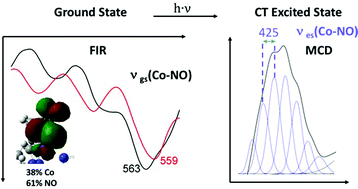A cobalt–nitrosyl complex with a hindered hydrotris(pyrazolyl)borate coligand: detailed electronic structure, and reactivity towards dioxygen†‡
Abstract
The cobalt–nitrosyl complex [Co(NO)(L3)] is supported by a highly hindered tridentate nitrogen ligand, hydrotris(3-tertiary butyl-5-isopropyl-1-pyrazolyl)borate (denoted as L3−), and shows a linear Co–N–O unit. This complex was prepared by the reaction of the potassium salt of L3− with the cobalt–nitrosyl precursor [Co(NO)2(tmeda)](BPh4) (tmeda = N,N,N,′N′-tetramethylethylenediamine). The obtained cobalt–nitrosyl complex as well as the corresponding products from the reaction with dioxygen, [Co(η2-O2N)(L3)] and [Co(η2-O2NO)(L3)], were characterised by X-ray crystallography and a number of spectroscopic methods including IR/far-IR, UV-Vis, and NMR spectroscopy. We also performed MCD measurements and DFT calculations to further elucidate the electronic structure of [Co(NO)(L3)] and the optical properties of the complex. The MCD spectra reveal two NO-to-Co charge-transfer transitions with strong excited state displacements that give rise to vibrational progressions in the MCD spectra, indicative of a very covalent Co–NO bond. These results provide new insight into the properties of the Co–NO bond and the electron distribution in the complex, which is best described as [CoII(NO−)(L3)].

- This article is part of the themed collection: Frontiers in Spectroscopic Techniques in Inorganic Chemistry


 Please wait while we load your content...
Please wait while we load your content...